Gary Neal Hansen's Blog, page 33
May 10, 2018
Letters to a Young Pastor: The Children’s Sermon — Is it True?

 CC by Bill McChesney 2.0
CC by Bill McChesney 2.0Dear ______:
I do think you’ll be well on your way to a solid children’s sermon if you take up my challenge to make it one salient point from the text you are preaching to the grown-ups.
But that isn’t the whole journey. You still need to work hard at finding kid-friendly ways to get that biblical point across. I’ll write you more about that another time.
For today, though, I want to suggest that you start with the big picture. Think through the salient point you want to make. Once you plan out what you intend to say to the kids, take a look and ask this all-important question:
Is it true?
It is important to tell kids the truth. That’s especially true when you are telling them about God, the faith, salvation.
But there are so many ways this goes awry.
Is it True Theologically?
Let me tell you about the children’s sermon I’ve heard more often than any other. I must have heard half a dozen preachers deliver some variation of this.
The preacher sits down with the kids, Bible in hand. When they say what it is
A Bible… (duh)
the preacher asks if they know what it is for.
Then, whatever the kids say, the preacher says the Bible is our God-given user’s manual for living.
The preacher says that the Bible is very much like the user’s manual for a car — or the instruction manual for a complicated piece of electronics, or stereo equipment, or whatever.
I’ve heard it multiple ways, but it is usually the car thing.
That may well pass the Stephen Colbert test: it has “truthiness.” It feels or sounds true, whether it really is true or not.
But you need to push a little harder and see if it is actually true.
Test 1: When was the last time you had a time of prayer and meditation with your Chevy’s auto manual?
Think about what you really want people to do with their car’s manual. Do they do anything like what a Christian does with the Bible?
Do I read my auto manual? No, I put it away in the glove box so I can use it when I need it.
I don’t want Christians to hide their Bible away on a shelf just so they can look something up later.
Well, what should Christians be doing with their Bible? I want them to read it cover to cover, and know it well.
I certainly don’t do that with my car manual. With apologies to the technical writers out there, those things are a snooze.
Reading it is just a start. I want more than that. I want people to encounter God in the Word.
People need to read the Bible slowly, prayerfully, reflectively, and listen for the questions God is asking them, listen for the very personal words God is speaking to them.
No one in their right mind tries to encounter God in an auto manual.
Test 2: When was the last time you looked to the Bible for detailed factoids about your life and how to live it?
Let’s turn it around. If I don’t use my car manual the way I use my Bible, maybe I still should use my Bible the way I use my car manual.
I use my car manual to find necessary facts for the upkeep and repair of my car.
Okay, there are people who approach the Bible that way. Some people do find the theological equivalent of the proper tire pressure and oil viscosity, and what the “check engine light” might mean.
These might be the people who put together detailed lists of Bible commands, or Bible promises, or Bible prophesies.
But if you read the Bible cover to cover, then read it prayerfully and reflectively, you’ll find it is actually quite unlike those user-manual instruction books.
The Bible is God’s Word, yes indeed, but God didn’t make it simple and user-friendly as a way to find guidance.. Within its pages you have to wrestle with things.
Like how the same God communicates in different kinds of literature (law, poetry, narrative, letter…)
And how the same God asked Abraham to sacrifice his son, and forbids child sacrifice
And how God chose people in polygamous cultures and monogamous cultures
And how God chose to use adulterous and murderous people while the Ten Commandments forbid both adultery and murder.
I’m thinking if you use the Bible like a user’s manual, you stand a strong chance of adding the wrong kind of oil — or that maybe your tire pressure is already set a bit too high.
Unconscious Honesty
You can actually tell a lot about a preacher’s REAL theology from the children’s sermon.
Someone who tells kids the Bible is a lot like a car user’s manual is not saying something true about the Bible. And that children’s sermon may not tell you much about the preacher’s official doctrine.
But the preacher is showing you something very true, and maybe something troubling, about his or her gut-level day-to-day theology.
So if your pulpit supply invitation this weekend includes a children’s sermon again, keep it true.
Blessings,
Gary
++++++++++++
I’d love to send all of these Letters to a Young Pastor straight to your inbox — along with other new articles and announcements. Just scroll down to the black box with the orange button to subscribe to my weekly(ish) newsletter…
The post Letters to a Young Pastor: The Children’s Sermon — Is it True? appeared first on Gary Neal Hansen.
May 7, 2018
Monday Meditation — RCL Year B, 7th Sunday of Easter, John 17:6-19

 In Between
In BetweenNext Sunday’s Gospel text comes at a unique moment in the Church year.
We had 40 days of Lent in preparation, culminating with Holy Week and the events of the Passion.
Then the great even itself, Easter Sunday, which begins a new season of 50 days ending at Pentecost with the outpouring of the Holy Spirit. Those 50 days are all Easter, and in them we revel in the new life Christ brings when he conquers death.
Thursday, ten days before Pentecost, is the day of Christ’s Ascension into heaven. Then comes the 7th Sunday of Easter, the “in between” Sunday.
The 7th Sunday of Easter
On the 7th Sunday of Easter,
Christ is no longer physically present with the disciples, but
The Holy Spirit has not yet forced them out into mission
I think it is a very typical moment for the experience of the Christian life. We know Christ is risen, but like the Apostles before Pentecost we feel powerless to face the world.
The first reading for this Sunday in year B comes from the first chapter of Acts and focuses on that in-between moment in ways the Gospel reading can’t.
John 17:6-19
This week’s Gospel, John 17:6-19, comfortingly points us back to Jesus’ last meal with his friends and his great and mysterious prayer after dinner.
Jesus is acutely aware that he is about to leave them. He has done all he can to protect his friends, but now he must entrust them to his Father’s care.
I’m interested in the “cast of characters” recounted in Jesus’ prayer. It boils down to four.
There are two divine Persons:
The Father.
Jesus.
And there are two categories of people:
The disciples who belong to Jesus.
The world.
Jesus’ prayer bounces around among these parties, emphasizing in turn belonging, being informed, and being sent.
Belonging
The disciples originally belonged to the Father, and the Father has given them to the Son.
While he was with them, Jesus the Son protected the disciples, but now they go back under the original protection of the Father.
They are to belong to each other in relationship as close as the Father and the Son.
Being Informed
Jesus was sent to reveal the Father to the disciples, passing on all the Father’s words to them.
They heard and kept what they learned — it was transformative, effective in their living.
What they have learned makes them distinct from the world — even “hated” by the world.
Being Sent
But there is a hidden key in what they learn: What they learn is that the Son was “sent” by the Father. This “sentness” seems to be crucial to true and transforming faith.
On the one hand it is Jesus’ summary of the words of God which he passed on:
…for the words that you gave to me I have given to them, and they have received them and know in truth that I came from you; and they have believed that you sent me.” (John 17:8 NRSV)
On the other hand, it is Jesus’ summary of what is going to be the relation of the disciples to the world:
As you have sent me into the world, so I have sent them into the world.” (John 17:18 NRSV)
I go into this week meditating on faith — faith as the word from God that Jesus is “sent,” and my identity as one who is also “sent” because I belong to God and to Christ.
Jesus prays that he sends us in the same way as he was sent. He gives us the big green light to GO.
Our “Sentness”
Well how was he sent? Among other things…
He came in person.
He came to speak the true word from his Father.
He came fully aware, and quite content, that he and his people would be distinct from the world.
I wonder what it means for me to be sent in person? How can I truly be present, honestly show up, in my relationships?
I wonder what it might mean for me to speak truly the words of the Father that come to me from Jesus? How can I speak more truly, and a truth that befits the character of Jesus?
I wonder what it means for a Christian to be distinct from the world in this society? How is belonging to Jesus, and living truly according to his character, marking my life?
++++++++++++
I’d love to send these meditations (along with other new articles and announcements) straight to your inbox. Scroll down to the black box with the orange button to sign up for my weekly(ish) newsletter.
The post Monday Meditation — RCL Year B, 7th Sunday of Easter, John 17:6-19 appeared first on Gary Neal Hansen.
May 5, 2018
First Visit to an Orthodox Church (pt. 3): Eyes vs Ears
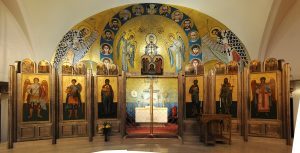
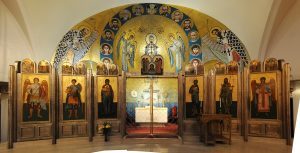 CC by Joe Mabel-SA2.0
CC by Joe Mabel-SA2.0Step into the Nave
Then you walk into the main worship space. Look around. You will see icons.
Lots and lots of icons.
You will have come into the “nave,” the place where the congregation gathers, through a door on the West wall. Ahead of you, toward the East you will see a wall, or screen of icons. It is called the “iconostasis” and behind it is the “sanctuary” where the altar table is located.
(Catholics call it an “altar,” where Christ’s sacrifice is re-presented. Protestants call it a “table,” where the Lord’s Supper is served. Orthodox call it by both terms and keep both meanings.)
Icons
You are probably surrounded by icons.
For instance, in the Orthodox church I attend most regularly you would see
Twenty-three icons painted on the North wall (name-saints of members), plus three in stained glass.
Twenty-three more on the South wall (more name-saints), plus three more in stained glass.
Twenty-four on the West wall (two for each of the twelve major feasts), plus three more in tapestries.
Eight major figures in the bottom row of the iconostasis.
Twelve apostles plus three major feasts in the second row of the iconostasis.
The crucifixion in three icons on the top of the iconostasis.
Two huge icons of the Last Supper high on the left and right of the East wall, one of six apostles receiving the cup, and the other of six apostles receiving the bread.
Mary high in the center of the East wall, above the altar table.
And of course Christ, the Ruler of All, looking down from the very top of the dome.
Plus over a dozen more here and there.
A lot of Protestants seeing over a hundred icons in a church will quickly think “It’s so … Catholic!”
But there are big differences between Orthodox and Catholic church art. For one, the Orthodox won’t have any statues. Paint, glass, and tapestry but it is always two dimensional.
And if the iconography is traditional they will look very different from Catholic paintings.
Icons can look simplistic, with the perspective all “wrong” in portrayals of biblical scenes. But they aren’t trying for the realism of the Western Renaissance.
Faces can look emotionless or stern — but they aren’t striving for the heartrending feeling of so much Catholic devotional art.
There is a whole language of Orthodox iconography — which is why they call the making of icons “writing” rather than “painting.” It is a language of biblical interpretation and theology in a vocabulary of light, lines, colors and proportions.
Light
The specifics of that language are a subject far too large and complex for this post. I’ll just mention one aspect:
You may notice a particular quality of the light in the church. It isn’t accounted for by stained glass windows. When it is dark outside and the church lights are barely lit there can still be a mysterious warm glow in the room.
That glow? It is from the icons. Really.
In traditional icons the halos (and sometimes whole backgrounds) are a layer of genuine gold leaf. That real gold captures whatever light is in the room and reflects it back — it can seems to amplify it.
And that light is part of the language of icons. The people they portray are saints because the light of Christ shone through them.
The light shines even in the darkness of our world and our lives. But the darkness does not overcome it.
Now when many Protestants see all those images we have one or two reactions.
We think it is idolatry.
We think it is gaudy.
Let me say something about the objections, then about what the Orthodox see in the same images.
1. Idolatry?
The Protestant world has a longstanding, deep-rooted objection to idolatry. And with good reason. The commandment against idolatry is one of the Big Ten.
Back in the sixteenth century, the first Protestants were converts from medieval Catholicism (which, by the way, is very different from the Catholicism you find today).
Those first converts knew from their own experience that ill-informed Christians could give worship to statues and paintings — worship that belonged only to God.
They knew from their own experience that devotion to the saints depicted in church art could displace people’s devotion to Jesus, and to the God who created heaven and earth.
That’s idolatry.
When church buildings that had previously been Catholic were transferred to Protestant use, frescos of the saints were sometimes painted over. Images of the saints were sometimes replaced with quotations from Scripture.
Even now, centuries later, those old issues rattle around in our corporate sensibilities. We see a painted image of Mary or another saint, and we can hardly help condemning it as an idol.
But the Orthodox are quite clear about what they are doing with their icons — and the Orthodox are all about theology. They are never worshipping in image, and they are never worshipping a saint. Read on, dear reader, read on and you will see.
2. Gaudy?
Protestant opposition to idolatry led to a very different sense of what a church ought to look like.
In North America, when Protestant colonists built churches from scratch, they made them very plain inside.
Walls were painted white, rather than full of images.
Windows were ordinary glass, not stained glass.
Furnishings were simple — like an ordinary dining table for the Lord’s Supper.
And everything was focused on the pulpit.
Small surprise, then, that Protestants see colorful icons with rich golden halos on every wall plus the ceiling and think it’s a bit problematic. The churches we were raised in just didn’t look like that. At all.
Eyes vs Ears
What lies behind the difference is not a failure to understand idolatry. The difference is in how two vast cultural traditions think people receive the gospel and worship the invisible God who created all things.
It is a difference of eyes vs ears.
I’ve heard it said that the Puritans liked plain glass windows so that “the clear light of reason” could shine through — instead of, I suppose, superstition and idolatry.
That Puritan emphasis on “reason” is actually a big deal in the general Protestant sensibility.
We Protestants, especially back in our sixteenth-century beginnings, came to church to hear the gospel. Our leaders were convinced that what we needed to break free of medieval superstition and ignorance was a fully-informed, well-educated biblical faith. As Paul put it,
… how are they to call on one in whom they have not believed? And how are they to believe in one of whom they have never heard? And how are they to hear without someone to proclaim him? … So faith comes from what is heard, and what is heard comes through the word of Christ. (Romans 10:14-17 NRSV)
Worship, for Protestants, became primarily a matter of what you hear with your ears and what you think about and decide about in your mind.
Our churches are built for hearing and learning through the preached Word. We tend to be suspicious of forms of worship that don’t appeal to our ears and our minds, or that call for us to engage other parts of ourselves in worship.
But for the Orthodox, hearing is only one way the gospel reaches you. They give more credence to the Psalmist who said
O taste and see that the Lord is good… (Psalm 34:8 NRSV)
The Communion of Saints
So what do the Orthodox see when they enter that room full of images? They see something many Protestants affirm when they say the Apostles’ Creed:
I believe in … the communion of saints.
And the Orthodox think of this as a present reality and as something very biblical indeed.
Take a look at Hebrews 11: The letter lists a whole bunch of Old Testament figures as models of faith.
Then check out chapter 12: These long-dead figures are considered alive, a “great cloud of witnesses.”
Finally flip forward to Revelation 4 and 5: The saints and martyrs, kings and creatures, all surround God’s throne in worship.
When you enter the church, the icons remind you of all the other people who are, right now, worshipping God. Remember, the idea of Orthodox worship is that you are stepping into the throne room of heaven itself.
Of course you are surrounded by saints of ages past. How could you worship without them?
Niggling Doubts
But somehow you still can’t help but object: Don’t the Ten Commandments forbid this kind of thing? Aren’t we told not to make images of God and worship them?
It is a good question. But the Orthodox are living well within the law.
Images of God? Jesus Christ yes, but not the Father. And you won’t find icons of the invisible essence of God.
Remember what happened in the incarnation? According to John,
… the Word became flesh and lived among us, and we have seen his glory…. No one has ever seen God. It is God the only Son, who is close to the Father’s heart, who has made him known. (John 1:14-18 NRSV)
And as Paul put it Jesus is
the image of the invisible God… (Colossians 1:15)
God himself chose to make his image visible. The Orthodox understand it as permission to portray Jesus, who is fully God, in images.
But what about all those other images of mere humans?
In an important way, they too are images of Jesus — because a saint is someone whose life shines forth Christ, transformed into his image (2 Corinthians 3:18).
Windows
When you look at an icon, you don’t look at the paint on the board. You don’t even focus on the mere human person who is portrayed. You first see the person, but the point is to look through him or her to Jesus who’s glory that person helped reveal.
Icons are essentially windows, not picture portraits.
So both Protestant and Orthodox churches have windows. And what passes through the windows is important to both traditions.
The Protestant wants reason to come in, to develop a well-informed faith with a rich understanding of the Word.
The Orthodox wants to see through the icon, as a window into mystery.
I hope as you worship you will take the time to look at the icons.
Spot the ones that show scenes rather than portraits. See if you can tell what story is being told, and what is being emphasized about the text.
Then look at an icon of Jesus. Think about the wonder of Christ, fully God and fully human. Remember how he brings salvation by who he is, by what he teaches, by the gift of his death and resurrection.
Take a look at an icon of Mary. Who’s that on her lap? Think about the wonder of her place in salvation history, and the transforming intimacy of bearing and raising God’s own Son.
See if you can recognize other figures. You might be able to tell who some are by clues in the picture or by inscriptions — or you might not. But think of saints that you have known — people whose intimacy with Jesus and whose obedience to his way and his will have made them shine with the glorious light of Christ.
And give thanks.
That’s the beginning of letting the gospel come to you through your eyes as well as your ears.
++++++++++++
This post is the third in a series. To read from the beginning, click here.
I’d love to send you all these Orthodoxy posts straight to your inbox, along with other new articles and announcements. Scroll down to the black box with the orange button to subscribe to my weekly(ish) newsletter.
The post First Visit to an Orthodox Church (pt. 3): Eyes vs Ears appeared first on Gary Neal Hansen.
May 3, 2018
Letters to a Young Pastor: The Children’s Sermon — One Salient Point

 Dear ______:
Dear ______:
I hear your objection to preaching a children’s sermon that is rooted in the main text you are preaching to the grown-ups. But I don’t think it is really a problem.
Yes, some parts of Scripture are kind of “R-rated” or at least “PG-13.” But how often (really, let’s be honest here) do you hear the racy bits or the violent bits preached in the grown-up sermons?
The lectionaries leave them out (sometimes without indicating the editorial trimming) and very few “lectio continua” preachers ever choose to preach through the books those passages are found in.
When the Text is PG-13?
It can sneak up on you though. When I was preaching a series on the Ten Commandments I used my children’s sermon to explain each one to the kids.
Then we got to “Thou shalt not commit adultery.”
How did I miss that when I was thinking the project through?
I didn’t really want to explain sex to the kids in worship. These were little kids. They were years away from the biological facts involved, and years further away from thinking about marriage. But how else to draw the one salient point from the text for them?
But then I realized the point they absolutely could understand: promises.
Kids totally get promises. They are convinced that if their parents say “maybe” there will be ice cream, the promise is now sworn and established.
And kids can understand that moms and dads make promises to each other — especially if they have ever been to a wedding.
So in the children’s sermon that day I talked about the command in terms of married people keeping their promises to each other.
No need to expound on the particular promises that Moses had in mind, and which still put many marriages to the test.
What I said was one key age-appropriate element of the text.
I felt like I’d dodged a bullet on that one. The looks on the grown-ups’ faces told me the parents thought so too.
A Boundary for Creativity to Grow With
Committing to preaching the message of the text, both to the kids and to the grown-ups, can give you tremors at times, but it provides a healthy boundary to grow within.
On the one hand, it can keep you from your own unhealthy extremes. We all have our pet issues, and left to our own devices our sermons would gravitate back to them time and again.
Having to dig into a particular text that is pitched to you either by the lectionary or by the book you are preaching through, means you have to wrestle with other, not-so-favorite ideas. And the good news is, the text will force you to wrestle with what God has been saying to humanity.
On the other hand, it can be a sort of trellis for the arbor of your creativity. I don’t know if you have done much gardening, but there are some plants that will thrive by climbing up and around a structure like a trellis.
Without the frame, I suppose the climbing vine would just slither on the ground and get mowed with the grass.
Human creativity often works this way too. Think about the poetry that has lasted centuries. Take Shakespeare’s sonnets. He didn’t just pour his feelings onto the page. He chose to fit them into a known pattern.
This many lines, no more.
Every line to this meter.
Rhyme it here, not there.
The result of all that constraint? Creativity. People still read those sonnets — they study them, and love them.
So my point: Setting out to write a children’s sermon that will focus on a passage of Scripture is a constraint that will improve your result.
Your Goal: One Salient Point
And my method: Find one salient point in that text, and communicate it in kid-friendly ways.
You can’t make all the points you’ll make to the grown-ups.
For one thing the kids won’t listen to you for fifteen or twenty minutes.
For another, the grown ups will probably need to hear a different point.
Don’t be surprised, please, that I say the text might have different points for different hearers.
We Protestants have been a bit foolish over the years thinking every text has precisely one meaning. The medievals were much wiser on this: they assumed every text had four different meanings.
God has something to say to each of us, and it will vary by
who we are,
where we are in life, and
the questions life is forcing us to ask.
Kids are in a different place than grown-ups. Their lives are hard — just differently hard than ours. You need to love them enough to try to figure out what they face in life, and then listen to the text for them.
The challenge of preaching to children is the challenge of cross-cultural ministry. Jesus came all the way from heaven to speak to us in our own flesh. It isn’t asking too much to say we need to try speak the Bible’s message in ways children hear as helpful.
Blessings,
Gary
++++++++++++
I’d love to send every one of my Letters to a Young Pastor straight to your inbox — along with other new articles and announcements. Just scroll down to the black box with the orange button to sign up for my weekly(ish) newsletter and all this will be yours…
The post Letters to a Young Pastor: The Children’s Sermon — One Salient Point appeared first on Gary Neal Hansen.
April 30, 2018
Monday Meditation — RCL Year B, 6th Sunday of Easter, John 15:9-17
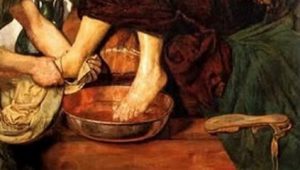
(My “Monday Meditations” are a personal dive into the Gospel text assigned for the coming Sunday, the Sixth Sunday of Easter, in the Revised Common Lectionary.)
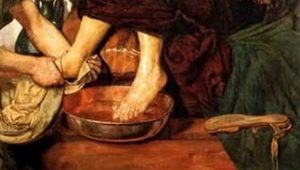 John 15:9-17
John 15:9-17Next Sunday’s texts are again completely lacking in explicit reference to the resurrection. I find this astonishing, but will not belabor the point.
Our task to read the texts in light of the resurrection — as portraits of the life made possible for us by Christ’s rising, conquering death by death.
This week’s Gospel text continues the passage begun last week: the speech in the upper room when Jesus declared that he was the “vine” and called us to “abide” in him.
As in many of his speeches in John it has about as many emphases as it has verses, but today one pair of ideas stands out to me:
The Paradox: Joy and Obedience
Jesus wants us to have genuine, full joy — and counter-culturally, we get this joy by obedience.
In Western culture, we love freedom more than obedience.
We often assume that anybody talking about obedience is stuck in “works righteousness” (if we come from a perspective of classical Protestant thought)
Or we assume someone talking of obedience is unenlightened, stuck in guilt or immaturity (if we come from a more psychological predisposition).
We assume that freedom means not being constrained by any external requirements, and we assume that such freedom will lead to joy.
This happens on the right when it comes to gun rights: constraint on personal liberty is a deep and joy-killing problem.
This happens not the left when it comes to abortion rights: constraint on personal liberty is a deep and joy-killing problem.
Well just be glad that this passage doesn’t mention guns or abortion any more than it mentions the resurrection. We don’t have to pursue those trains of thought today.
But in an oversimplified way, I think they show how deeply committed we are to freedom in a way that sets obedience on a lower tier among our cultural priories.
The Command to Love as Jesus Loved
The text does, however, mention obedience. It is a very specific obedience, when you look at it. It does not set us up to obey all the laws of Moses, or even every imperative of Jesus.
Jesus speaks of one particular command:
This is my commandment, that you love one another as I have loved you” (John 15:12, NRSV).
Well that’s bracing. Jesus stepped down from the glory of his role as Second Person of the Trinity and schlepped around with the likes of you and me.
He did not desperately grasp the honor he deserved. He served us.
He healed, and fed, and blessed all those he met. When approached by the disabled, the foreign, the outcast, and the unclean he dealt with them as equals. He looked them in the eye. He spoke to them. He cared for them in their needs.
Laying Down My Life
It all comes down to the explanation Jesus offered as soon as he had introduced the command:
No one has greater love than this, to lay down one’s life for one’s friends” (John 15:13 NRSV).
They had just seen this vividly illustrated: Two chapters earlier Jesus had taken off his clothes and washed their feet as a servant would do.
They would soon see it vividly illustrated again: Three chapters later Jesus would be betrayed, arrested, tried, and executed — his life entirely laid down for them.
All of this turns last week’s cheery message of abiding in Jesus in a rather sober direction. Jesus does pep it up again, offering friendship, answered prayer, and a loving community. But we are told that this fulness of joy comes by laying down our lives for others.
Does This Really Work?
Repeated, daily, service of others. That’s Jesus’ way to joy.
In any given instance, I find it seems more likely that joy will come by avoidance.
I am very attached to my own pleasure to my own moment-by-moment preferences. This is what I mistake for freedom — and it is my life, which Jesus calls me to lay down.
Just as he did.
I used to think that this joy would come in the very present moment. Somehow, because it was obedience offered to Jesus I would be happy in my service. But when my service of others includes scrubbing the bathroom fixtures I find this is not so.
The joy has to come further down the road, in a life transformed so that my self-serving ways are overcome, when more and more the service Christ exemplified becomes my new, or renewed, nature.
At least I hope so.
Meanwhile, obedience to this great law of love comes one complicated day at a time.
++++++++++++
I’d love to send every one of these Monday Meditations straight to your inbox, along with other new articles and announcements. Just scroll down to the black box with the orange button and sign up for my weekly(ish) newsletter and all this will be yours…
The post Monday Meditation — RCL Year B, 6th Sunday of Easter, John 15:9-17 appeared first on Gary Neal Hansen.
April 26, 2018
Letters to a Young Pastor: The Children’s Sermon — Preaching on Other Topics
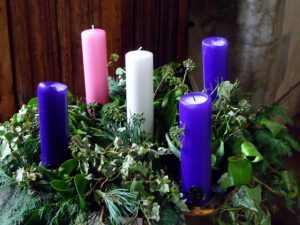
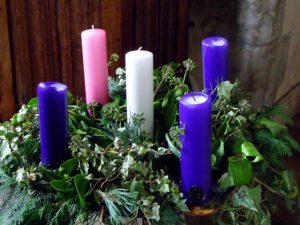 CC by Nick Macneill-SA 2.0
CC by Nick Macneill-SA 2.0Dear ______:
Yes, you are right, of course. I too have heard some really good children’s sermons that are on topics other than the biblical text behind the grown-ups sermon. I’ve even preached some.
Good Practice, Not Unbendable Law
When I said that the biblical text of the morning should be the topic of your children’s sermon I was speaking in terms of a general rule — what to do most of the time, unless some other issue is more important that day.
I think it is analogous to being a lectionary preacher on a Sunday after a major national or local tragedy. Sometimes you just need to claim the prerogative of speaking a word of comfort to a community in pain.
At least in my denomination the pastor is the one who decides what text is read and preached, so it is easy to just make a switch. I’ve heard preachers in churches with firmly fixed lectionaries read the assigned text but simply preach on the more relevant and necessary topic.
As a preacher you are not the slave of a lectionary or another pre-selected schedule of texts. You are there as a shepherd of God’s flock, and a teacher in God’s school. Most of the time a lectionary or ongoing series will serve those needs.
But children’s sermons? Here you especially need that sense of being a shepherd and a teacher. That actually opens up a whole range of excellent topics.
Preaching on Other Topics
Here are a few that come to mind:
On a day when someone will be baptized or when the Lord’s Supper is to be celebrated, you can explain to the kids what one of the sacraments is all about.
On a saint’s day you can tell the story of that great influential role model for discipleship. (I had a great time telling the kids the truth about Santa Claus one notable St. Nicholas’ Day.)
On a day when the changing season of the Church year brings the sanctuary new colors, or other elements like an Advent wreath, you can explain what those things mean in the Church and the Christian life.
And you can take the opportunity to explain perfectly ordinary things as well.
The kids need to hear where the Lord’s Prayer comes from — and what it means.
They need to learn what the Apostles’ and Nicene Creed are.
You might explain why we sing psalms and hymns and spiritual songs — and you might help them understand one that they are singing that very day.
Why do you have an offering in the service?
Why are there different kinds of prayers each Sunday?
Why do you read the Bible in the service when people can read it at home?
Better Understanding, More Active Worship
The whole service is a mystery to kids — until someone helps them understand it. That’s why you should also be preaching on other topics to the kids. It’s part of letting your children’s sermons shepherd and educate the kids.
And then, with understanding, bit by bit you can teach them how to participate in worship. They really don’t have to sit there bored, or reading comic books, or playing games silently on someone’s phone. They can learn to worship.
By the way, none of those explanations are going to be wasted on the grown-ups either! You would be surprised the number of life-long Christians who have never heard the most basic things about the church explained.
Blessings,
Gary
++++++++++++
This is part of an ongoing series on children’s sermons. Click here to start from the beginning.
I’d love to send each of these posts, plus other articles and announcements, right to your inbox. Just scroll down to the black box with the orange button to subscribe to my weekly(ish) newsletter — and get a free book too!
The post Letters to a Young Pastor: The Children’s Sermon — Preaching on Other Topics appeared first on Gary Neal Hansen.
April 24, 2018
First Visit to an Orthodox Church (pt. 2): Passageway vs Preparation
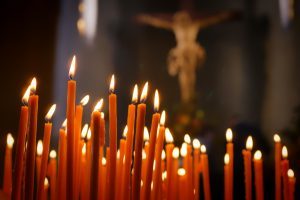
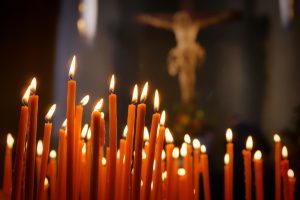 Last week I started writing about how to have a really excellent first visit to an Orthodox church. I think you need to be aware of several differences — just six or so — between the Christian East and the Christian West.
Last week I started writing about how to have a really excellent first visit to an Orthodox church. I think you need to be aware of several differences — just six or so — between the Christian East and the Christian West.
The first one is outside, when you look up and see a dome instead of a steeple.
Once you’ve found the front door and stepped inside, the next big difference between East and West smacks you upside the head.
The Narthex
The space inside the door of an Orthodox church is called the “narthex.” That’s what it’s called in traditional Western churches too. And you’ll find other similarities — though you will probably be more struck by the differences.
If your experience is anything like mine you expect a few basic things when passing through a church narthex.
Maybe a coat rack.
Probably information about the church and its ministries.
Hopefully a friendly person will welcome you, shake your hand, and give you some papers about the service.
But that’s it. The narthex of a Western church is basically a passageway.
You will find all or most of those things in the narthex of the Orthodox church too.
However, on your first visit you might not notice any of them. There will be too much going on. And the differences between your own background and Orthodoxy will be too prominent.
Passageway vs Preparation
When you step inside, look around. You will see paintings (“icons” is their official name) of Jesus, and of his mother Mary, and probably of other saints.
There are probably candles burning in front of the icons, and either racks or sandboxes to hold more candles.
And you will notice that the members actually stop in the narthex for a bit.
And they do stuff while they are there.
They stand in front of the icons.
They may pick up a candle, maybe more than one, and light it, placing it before an icon.
They make the sign of the cross.
They may touch the ground, or gesture toward it.
They may kiss the icons, or touch them with their fingertips.
They may do all of this repeatedly.
At about this point the died-in-the-wool Protestant begins to, in technical terms, freak out.
One of the impulses of early Protestantism was a biblical objection to what they saw as the idolatry of medieval Catholic popular piety.
All the action in the narthex sets off those inner alarms.
A bit lost in this space, we hear
Danger! Danger Will Robinson!
I’m convinced that the truer inner message, as we are surrounded by a surprisingly colorful foreign world, is more like
Toto — I have a feeling we aren’t in Kansas anymore.
More about icons in the next installment in this series. For the moment you’ll just have to trust me:
No Orthodox Christian in that narthex is worshiping an idol. Ever. Really.
Praying a Prayer
What they are doing is praying to God. That’s what the Narthex is for.
The Orthodox are encouraged to prepare for worship in a variety of ways even before they arrive at the building. When they step into the narthex, the preparations become even more focused.
There is a good chance that they start by silently praying,
I will enter Your house and worship toward Your holy temple in the fear of You. Lead me, O Lord, in Your righteousness because of my enemies; make my way straight before You, that with a pure heart I may glorify You forever: one divine power worshipped in three Persons: Father, Son and Holy Spirit, now and ever and unto ages of ages. Amen.
(I’ve found this prayer, with variations probably due to translation, on Greek Orthodox, Antiochian Orthodox, and Orthodox Church of America websites.)
They may pray other particular prayers before the icons of Jesus and of Mary. Or they may be bringing their own needs to God in their own words. But the narthex is more than a passageway with a coat rack. It is a place of prayer.
Their prayer looks different from yours on the outside. The chances are good that in the heart it is very similar.
But now, while everyone around you is praying and getting ready to enter the worship life of heaven itself under that dome, let me give you a couple of invitations (and a handy pro-tip) that, I hope, will allow you to relax.
I’m taking this on myself, by the way, but I think that your local Orthodox church is very likely to agree.
Lighting a Candle
First,
You are invited light a candle.
You are also invited to not light one.
Lighting a candle is not an “insiders” thing that visitors can’t do. It’s just a part of praying.
So, if it helps you focus on bringing your prayers to God, then you can put an offering in the box, take a candle, and light it from one of those that is already in the stand. Then place it in the stand or sandbox.
Likewise if you want to follow the old policy of
When in Byzantium, do as the Byzantines do.
But if you don’t want to light a candle, then that’s fine too. Nobody is making a list of who does and doesn’t. (Or if someone is making a list, they should probably mention it next time they go to confession.)
Making the Sign of the Cross
Second,
You are invited to make the sign of the cross.
You are also invited not to make it.
This again is not something reserved for insiders. Nor is it something that everyone does precisely in unison. It is a way of showing your reverence for the cross of Christ which brought us salvation, and of honoring God, the Holy Trinity.
You’ll find that most people make the sign of the cross whenever the three Persons of the Trinity are named. But I’ve seen individuals not do so. And you’ll see individuals making the sign of the cross at other times, apparently for reasons of their own.
There doesn’t seem to be a wrong time to give glory to God.
If you choose to make the sign of the cross, it will seem perfectly ordinary to all the Orthodox around you.
If you don’t, I doubt anyone will be bothered.
Pro-tip: If you decide to make the sign of the cross, here’s how to do it.
First, unlike in Catholic practice, you hold your hand in a particular way:
Bring the thumb and first two fingers of your right hand together — a reminder of the Three Persons of the Trinity.
Then tuck your last two fingers against your palm — a reminder of the two natures of Christ, divine and human.
Then it goes in a different pattern than Catholics:
First touch your forehead (“In the name of the Father…”),
then your belly button (“…and the Son…”),
then your right shoulder,
and finally your left shoulder (“…and the Holy Spirit”).
My own way to remember this is “up, down, close, across.”
Preparing for Mystery
Last of all, you are warmly invited to be reverently baffled by what is coming.
They will probably hand you a bulletin of some kind, but it will not help you follow the Liturgy at all.
They may hand you a book or pamphlet with the text of the whole Liturgy, but it is very unlikely that even this will help you follow along.
There are many local and seasonal variations to the largely unchanging Liturgy. So much so that I’ve never seen a printed version that exactly matched what happened on any particular day.
So don’t expect to follow it word by word. Expect instead to experience it.
Let yourself be open to the unfolding drama.
The parts of you that usually respond to a worship service may not get much attention. But you might find yourself moved in surprising ways by what Scripture calls “the beauty of holiness.”
Ready to step inside?
++++++++++++
I’d love to send all the installments of this series right to your inbox — along with links to other new articles and announcements. Just scroll down to the black box with the orange button to sign up for my weekly(ish) newsletter.
The post First Visit to an Orthodox Church (pt. 2): Passageway vs Preparation appeared first on Gary Neal Hansen.
April 23, 2018
Monday Meditation — RCL Year B, 5th Sunday of Easter, John 15:1-8

 I find it surprising that the Revised Common Lectionary’s cycle of Gospel texts in Easter season includes so little that is explicitly on the Resurrection. Last week there was, at least, the passing reference to Jesus taking his life up again after laying it down for his sheep.
I find it surprising that the Revised Common Lectionary’s cycle of Gospel texts in Easter season includes so little that is explicitly on the Resurrection. Last week there was, at least, the passing reference to Jesus taking his life up again after laying it down for his sheep.
John 15:1-8
This week? Nothing.
At least nothing explicit. Of course we can say that these words of Jesus are about life in light of the resurrection even if they appear in the gospel prior to Jesus’ death.
Oh well. I’ve long said that we Protestants have a very hard time focusing on Easter and the Resurrection.
But whatever the intent of the committee that compiled our lectionary, on Monday, most of the way through Easter, I find the text they chose gives me a helpful chance to refocus.
“I Am the Vine”
Jesus’ statement that he is the Vine, and we the branches, is familiar and comforting. For the preachers, especially, in this season it comes as a healthful reminder, a re-orientation to what is most essential to life. The image is, ultimately, repentance: a change of mind.
That is, when we have pressed hard through Lent and Holy Week, then collapsed a bit in the aftermath, we must look up and decide where to go.
We could continue on the path to burnout — just get back in the grind of service preparation, administration, visitation… just keep putting out the fires, dealing with whatever presents itself as most urgent.
Or, in this moment when the church’s life is a little calmer, we could consider what is most essential.
The Comfort of Abiding
What matters most is that I belong to God in Jesus Christ. I am united to Jesus in Baptism. In the Eucharist I am brought again and again to the fact that I am flesh of his flesh, that his lifeblood now flows within me.
And conceptually, nothing in the gospels conveys that vital connection better than the image of a vine with its branches. If I’m a branch of Christ the vine, I need to stay close, revel in my connection to him, so that his life flows all the more.
As Spring finally comes, I need that connection so that I bloom, and leaf out, and bear fruit. Lord how I want that sense of life flowing within me, filling me, bubbling over into the world.
The Discomfort of Pruning
But there is the more sober side of this text. Now that I’m all redirected to union with Christ, he tells me his Father is in the pruning business.
Nobody gets off easy here.
Not bearing enough fruit? He cuts me off for kindling wood.
Bearing fruit? Trimmed and pruned to bear more fruit.
Ouch.
The Vinedresser seems to cut off all the living parts and ties the remainder to supports, in a shape remarkably like a cross.
And yet, it is worth it.
God prunes, and Jesus’ life flows so that life is genuinely fruitful — and the unity is such that Jesus can promise real transformation.
So close, so full of his own genuine life, that when I ask in prayer God will grant it. How could God not grant the prayer that bubbles up from Jesus’ own lifeblood in me?
Well, let’s say I’m glad for the promise. There is a long way to go in the transformation.
Wondering…
I wonder what in my life is already the fruit of abiding in the Vine, the overflow of Christ’s life within me?
I wonder, as I draw close to Christ, what will next need pruning?
I wonder what my life will feel like when I get pruned?
I wonder what my life will feel like when new life flows more fully from the Vine?
I wonder what fruit will look like?
++++++++++++
I’d love to send these Monday Meditations straight to your inbox, along with links to my other articles and announcements. If you scroll down to the black box with the orange button you can sign up for me weekly(ish) newsletter…plus get a free book.
The post Monday Meditation — RCL Year B, 5th Sunday of Easter, John 15:1-8 appeared first on Gary Neal Hansen.
April 19, 2018
Letters to a Young Pastor: The Children’s Sermon — Picking Your Topic
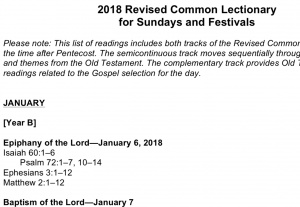
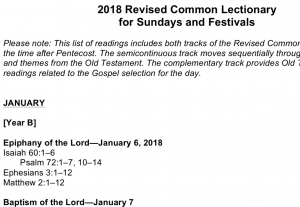 Dear ______:
Dear ______:
Okay, I promised some input on the actual contents of your children’s sermons.
I hope you don’t mind the extended rant about problems to avoid, but your actions are as much a witness to Christ (or, God forbid, a witness against him) as your words. That counts when preaching to grown-ups as well as the children’s sermon — and in your daily life, of course.
Picking Your Topic for the Children’s Sermon
There is a good bit to say, and so today I’ll just start with your explicit question:
How do I pick a topic for the children’s sermon?
The Lord often answered questions with more questions, so I’ll take the liberty of doing the same.
I ask you: How do you choose the topic of your grown-up sermon?
And once you answer that I’ll say, as Jesus is known to have said,
Go ye and do likewise.
Talk to the kids about the same biblical passage you are talking to the grown-ups about.
I’m always baffled when I visit a church and the preacher gives one message to the grown-ups and takes up a totally different topic for the kids.
At the very least, that’s inefficient. Why prepare to speak on two topics when you could focus your energy on just one?
But then, let’s be honest: a whole lot of pastors don’t actually prepare for their children’s sermons.
In addition though, it shows something about a pastor’s sense of the congregation: We spent the whole week digging into a passage to tell the grown-ups its message — so why do we think that the kids don’t need to hear it too?
Is it about our estimation of the children’s value as members of the congregation?
Is it maybe our estimation of the children’s ability to understand what the Bible is actually about?
Well it reveals something. I don’t think it is probably something good.
Picking Your Topic for the Grown-Up Sermon
So how do you decide what your grown-up sermon is going to be about? That’s something to think about now, while you are in seminary. There are lots of choices:
Many preach texts assigned by a lectionary, letting their denominations decide for them.
Many take up topics (kingdom parables, “I Am” sayings, the Lord’s Prayer, whatever) and create a sermon series, finding relevant texts and using the sermon as an opportunity for education.
Many preach almost at random, believing or hoping that the Spirit guides them to the text their congregation needs to hear about.
A lonely few take the Reformers as their role models and preach through a book of Scripture text by text, start to finish.
And some just preach the same messages over and over, taking a file of sermons from church to church in a sort of liturgical recycling program.
Whatever approach you end up taking, why not prepare a kid-level message from the text you’ll be preaching to the grown-ups?
Really: It’s a Children’s Sermon
I’m saying this knowing that it telegraphs assumptions that are different from those held by many. That is, I believe the “children’s sermon” really is a sermon.
If you look at how this part of the service appears in bulletins, you may find that I hold a minority opinion.
Some call it “the children’s story” whether they are telling a story or not.
Some call it “the children’s blessing” which certainly implies more “Mr Rogers Moment” than biblical exposition.
Some call it “the time for young disciples,” which could be anything, really, though it does imply that they ought to follow Jesus.
For my money it should be a children’s sermon. It is your job to teach the biblical faith to the kids, just like you do for the grown-ups. That doesn’t mean you should bore them — but you shouldn’t bore the grown-ups either.
You should communicate good news of Jesus Christ, and you should teach the joyful, helpful, challenging message of the Bible as a whole. And you should do it in ways appropriate to children. One good sign that you are doing that: they listen eagerly.
So tell me: How do you choose the topic of your grown-up sermon? And why would you choose a different topic for the kids?
Blessings,
Gary
++++++++++++
I’d love to send every new post in this series straight to your inbox. Scroll down to the black box with the orange button to sign up for my weekly(ish) newsletter with links to all my new articles and announcements.
This post is part of a series. Click here to start at the beginning…
The post Letters to a Young Pastor: The Children’s Sermon — Picking Your Topic appeared first on Gary Neal Hansen.
April 17, 2018
First Visit to an Orthodox Church: Domes vs. Steeples
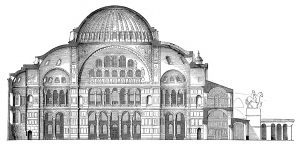
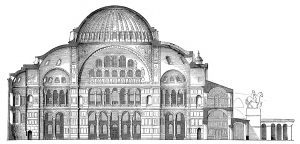 Hagia Sophia Laengsschnitt (public domain)
Hagia Sophia Laengsschnitt (public domain)If you’re a regular here on my blog you’ve seen me writing on a variety of topics relating to Orthodox Christianity.
I don’t mean “little ‘o’ orthodox” — like any Christianity with good theology.
We’re talking “big ‘O’ Orthodox” — Eastern Christianity, the part that was divided from the West back in 1054 and is still the second largest body in global Christianity.
It all ties into personal experience. Participating in the Vespers services of Orthodox churches in Dubuque and Pittsburgh has kept me grounded and growing in tumultuous times. So I’ve written about the theological richness of their hymns, the particular gifts of their special Lenten services, and about many of their saints.
So I thought to myself: What if one of my readers got intrigued about Orthodoxy and wanted to see it firsthand? You might look up your local Orthodox Church and stop by some Sunday morning.
It might happen.
And you might find yourself very confused by what you experience.
Making Sense of Your First Visit to an Orthodox Church
Here’s what often happens: A Protestant in an Orthodox church immediately says “It’s too Catholic!” — even though what is happening would actually be quite foreign to a Catholic as well.
I’d love instead for you to have a really positive encounter with Orthodox worship. I think if you know a few of the differences in advance, maybe just half a dozen, and know what they actually mean, then you are more likely to find the experience of Orthodoxy meaningful, inviting, and a catalyst to growth.
Common Ground
Rest assured that there is a vast amount of common ground between the Orthodox and Western branches of the faith.
They worship the same one God who is eternally the Trinity: three Persons, Father, Son, and Holy Spirit.
They worship, love, and follow the same Jesus Christ who is truly human and truly divine.
They take baptism and the Eucharist very seriously.
Those are just obvious starters.
Domes vs. Steeples
Assuming the church you visit was originally built as an Orthodox church, you can make your first important observation before you even get out of your car.
Look up.
See the shape of the roof line. Now compare in your mind with the Protestant or Catholic church down the street, or one you usually attend.
 Canterbury Cathedral CC WyrdLight.com-SA4.0
Canterbury Cathedral CC WyrdLight.com-SA4.0Most Protestant and Catholic churches are built with spires on top. The spire might be central. There might be more than one, at the corners. Whether it is a stone cathedral from the middle ages, or an early American clapboard meeting house, long and thin or short and squatty, our churches often have points.
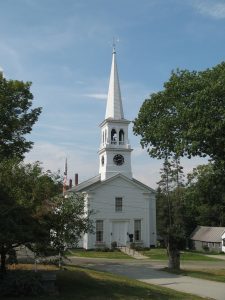 Peacham Vermont Church CC by Jared and Corin 2.0
Peacham Vermont Church CC by Jared and Corin 2.0Orthodox churches on the other hand, tend to be round on top. They have domes instead of spires.
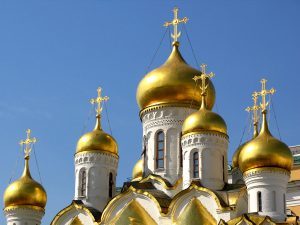 Onion domes of Cathedral of the Annunciation, CC Petar Milošević-SA 4.0
Onion domes of Cathedral of the Annunciation, CC Petar Milošević-SA 4.0Now sure, sometimes you see what are called “onion domes”: bulbous and round, with a small point in the middle. But you also see great rounded domes, modeled on the ancient Church of Holy Wisdom, Hagia Sophia in Istanbul (formerly Constantinople).
Witness vs. Presence
What’s the big deal?
Well, whether today’s worshippers think about it or not, the planners and architects embodied statements about their faith in the buildings they constructed.
Spires are on our churches to point our attention upward, toward heaven.
The building bears witness to a separate reality. “Come inside,” the building says, “and we’ll help you redirect your attention to God!” The building, and the faith we learn of, calls us to be witnesses.
We leave as representatives of the Body of Christ, called to bear that same witness, helping people turn toward Christ, to live in light of heaven.
That’s all good.
The church as dome sends a different message about the same faith: The dome is heaven, and we are invited in.
It is more about presence than about witness.
Think back to the first chapter of Genesis. God put a dome, a “firmament” over the earth. We look up at the sky and it looks as if we lived under a huge blue bowl — a dome.
An Orthodox church is a microcosm of heaven. The building calls out “Come in and enter God’s throne room.” When you get inside the worship space, you will probably find the ceiling painted sky blue — with Jesus at the very center, at the top of the dome, looking down as our ruler.
Entering an Orthodox church is not primarily about being pointed toward heaven.
You are understood to be entering into heaven itself.
I’ll say more, later in this series, about what you will see and experience there. But for now imagine the biblical underpinnings of Orthodox worship as the passages portraying God’s throne room.
Isaiah chapter 6 gives the prophet’s vision of God enthroned in the earthly temple, surrounded by angels that perpetually sing “Holy, Holy, Holy is the Lord Almighty! Heaven and earth are full of his glory!”
Revelation four and five look into heaven and find people and creatures surrounding God’s throne, eternally singing out in worship, “Holy, Holy, Holy is the Lord God almighty, who was, and is, and is to come!”
That’s what a dome is trying to tell you — and to invite you into.
Instruction vs. Experience
Even before you go in, the dome hints to you of a great continuum. All Christian worship finds its place on it. Instruction is on one end; experience is on the other.
I’m a Presbyterian. We are all about instruction. My tradition burst on the scene in 16th century Europe with a deep concern that the nominally Christian populace knew almost nothing about their faith.
Worship is about the Word of God, which we read, and preach, and respond to.
But we didn’t stop there with our explanation. Oh my no. Today in a Presbyterian service almost nothing comes without explanation.
We don’t just stand and sing a hymn. Someone explains which book it is in, what page it is on, what it is about, and why we are singing it just at this point of the service.
It can be hard to tell when the announcements break off and worship begins.
When you step inside an Orthodox church it is all about experience. You are at the absolute opposite end of the spectrum.
You will experience all kinds of things.
No one will explain anything. (Hey, that’s why I’m writing these blog posts.)
But that is exactly true to the concept. Going into this building is not an intellectual reminder of where you should aspire in your life. You are, for a brief while, stepping into the activity that is going on eternally in God’s throne room in heaven.
The church is your meeting point between heaven and earth. It is, as the Celtic Christians might say, a “thin place.”
It is almost all about experience. The activity of God’s throne room will unfold around you, and you will be there in the midst of it.
So before you go in, look up. Know that you are about to experience what the Orthodox think of as “the awe-inspiring mysteries of God.”
You should not to expect to be guided and directed step-by-step.
You should not think anything will be explained to you.
You will, on the other hand, be warmly welcome (whether anyone says so or not) to experience a foretaste, a real taste, of the life of heaven.
The first time you’ll probably do best to let the experience to roll over you. If you come back, more will grow familiar, taking on deeper and richer meaning.
If you strike up a friendship with a member or a priest they will surely explain what is going on, or guide you to helpful books. If you ask.
But the point is to be there.
++++++++++++
I’d love to send all these posts, as well as my other articles and announcements, directly to your inbox. Sign up for my weekly(ish) newsletter down there in the black box with the orange button, and they will wing their way to you across the interwebs…
The post First Visit to an Orthodox Church: Domes vs. Steeples appeared first on Gary Neal Hansen.



